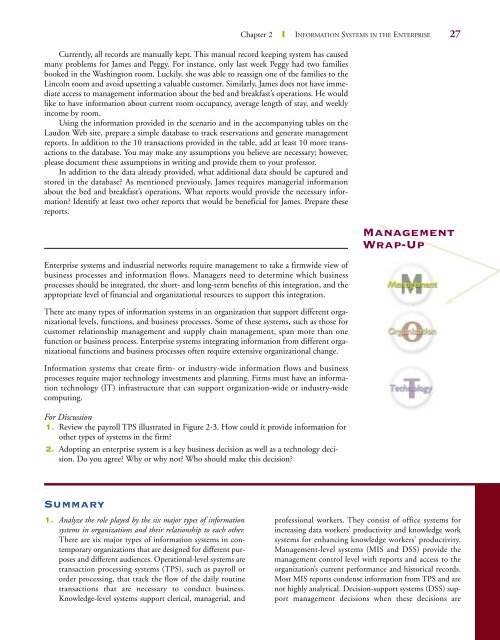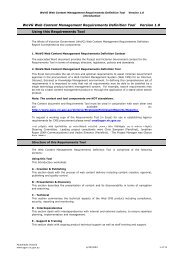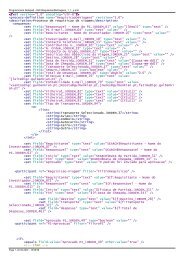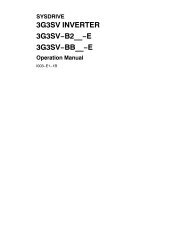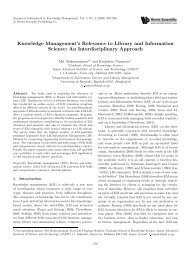2 Information Systems in the Enterprise - Main Web
2 Information Systems in the Enterprise - Main Web
2 Information Systems in the Enterprise - Main Web
You also want an ePaper? Increase the reach of your titles
YUMPU automatically turns print PDFs into web optimized ePapers that Google loves.
Currently, all records are manually kept. This manual record keep<strong>in</strong>g system has caused<br />
many problems for James and Peggy. For <strong>in</strong>stance, only last week Peggy had two families<br />
booked <strong>in</strong> <strong>the</strong> Wash<strong>in</strong>gton room. Luckily, she was able to reassign one of <strong>the</strong> families to <strong>the</strong><br />
L<strong>in</strong>coln room and avoid upsett<strong>in</strong>g a valuable customer. Similarly, James does not have immediate<br />
access to management <strong>in</strong>formation about <strong>the</strong> bed and breakfast’s operations. He would<br />
like to have <strong>in</strong>formation about current room occupancy, average length of stay, and weekly<br />
<strong>in</strong>come by room.<br />
Us<strong>in</strong>g <strong>the</strong> <strong>in</strong>formation provided <strong>in</strong> <strong>the</strong> scenario and <strong>in</strong> <strong>the</strong> accompany<strong>in</strong>g tables on <strong>the</strong><br />
Laudon <strong>Web</strong> site, prepare a simple database to track reservations and generate management<br />
reports. In addition to <strong>the</strong> 10 transactions provided <strong>in</strong> <strong>the</strong> table, add at least 10 more transactions<br />
to <strong>the</strong> database. You may make any assumptions you believe are necessary; however,<br />
please document <strong>the</strong>se assumptions <strong>in</strong> writ<strong>in</strong>g and provide <strong>the</strong>m to your professor.<br />
In addition to <strong>the</strong> data already provided, what additional data should be captured and<br />
stored <strong>in</strong> <strong>the</strong> database? As mentioned previously, James requires managerial <strong>in</strong>formation<br />
about <strong>the</strong> bed and breakfast’s operations. What reports would provide <strong>the</strong> necessary <strong>in</strong>formation?<br />
Identify at least two o<strong>the</strong>r reports that would be beneficial for James. Prepare <strong>the</strong>se<br />
reports.<br />
<strong>Enterprise</strong> systems and <strong>in</strong>dustrial networks require management to take a firmwide view of<br />
bus<strong>in</strong>ess processes and <strong>in</strong>formation flows. Managers need to determ<strong>in</strong>e which bus<strong>in</strong>ess<br />
processes should be <strong>in</strong>tegrated, <strong>the</strong> short- and long-term benefits of this <strong>in</strong>tegration, and <strong>the</strong><br />
appropriate level of f<strong>in</strong>ancial and organizational resources to support this <strong>in</strong>tegration.<br />
There are many types of <strong>in</strong>formation systems <strong>in</strong> an organization that support different organizational<br />
levels, functions, and bus<strong>in</strong>ess processes. Some of <strong>the</strong>se systems, such as those for<br />
customer relationship management and supply cha<strong>in</strong> management, span more than one<br />
function or bus<strong>in</strong>ess process. <strong>Enterprise</strong> systems <strong>in</strong>tegrat<strong>in</strong>g <strong>in</strong>formation from different organizational<br />
functions and bus<strong>in</strong>ess processes often require extensive organizational change.<br />
<strong>Information</strong> systems that create firm- or <strong>in</strong>dustry-wide <strong>in</strong>formation flows and bus<strong>in</strong>ess<br />
processes require major technology <strong>in</strong>vestments and plann<strong>in</strong>g. Firms must have an <strong>in</strong>formation<br />
technology (IT) <strong>in</strong>frastructure that can support organization-wide or <strong>in</strong>dustry-wide<br />
comput<strong>in</strong>g.<br />
For Discussion<br />
1. Review <strong>the</strong> payroll TPS illustrated <strong>in</strong> Figure 2-3. How could it provide <strong>in</strong>formation for<br />
o<strong>the</strong>r types of systems <strong>in</strong> <strong>the</strong> firm?<br />
2. Adopt<strong>in</strong>g an enterprise system is a key bus<strong>in</strong>ess decision as well as a technology decision.<br />
Do you agree? Why or why not? Who should make this decision?<br />
Summary<br />
1. Analyze <strong>the</strong> role played by <strong>the</strong> six major types of <strong>in</strong>formation<br />
systems <strong>in</strong> organizations and <strong>the</strong>ir relationship to each o<strong>the</strong>r.<br />
There are six major types of <strong>in</strong>formation systems <strong>in</strong> contemporary<br />
organizations that are designed for different purposes<br />
and different audiences. Operational-level systems are<br />
transaction process<strong>in</strong>g systems (TPS), such as payroll or<br />
order process<strong>in</strong>g, that track <strong>the</strong> flow of <strong>the</strong> daily rout<strong>in</strong>e<br />
transactions that are necessary to conduct bus<strong>in</strong>ess.<br />
Knowledge-level systems support clerical, managerial, and<br />
Chapter 2 ❙ INFORMATION SYSTEMS IN THE ENTERPRISE 27<br />
Management<br />
Wrap-Up<br />
professional workers. They consist of office systems for<br />
<strong>in</strong>creas<strong>in</strong>g data workers’ productivity and knowledge work<br />
systems for enhanc<strong>in</strong>g knowledge workers’ productivity.<br />
Management-level systems (MIS and DSS) provide <strong>the</strong><br />
management control level with reports and access to <strong>the</strong><br />
organization’s current performance and historical records.<br />
Most MIS reports condense <strong>in</strong>formation from TPS and are<br />
not highly analytical. Decision-support systems (DSS) support<br />
management decisions when <strong>the</strong>se decisions are


